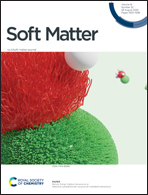Effect of metallacarborane salt H[COSANE] doping on the performance properties of polybenzimidazole membranes for high temperature PEMFCs†
Abstract
In this paper, a series of composite proton exchange membranes comprising a cobaltacarborane protonated H[Co(C2B9H11)2] named (H[COSANE]) and polybenzimidazole (PBI) for a high temperature proton exchange membrane fuel cell (PEMFC) is reported, with the aim of enhancing the proton conductivity of PBI membranes doped with phosphoric acid. The effects of the anion [Co(C2B9H11)2] concentration in three different polymeric matrices based on the PBI structure, poly(2,2′-(m-phenylene)-5,5′-bibenzimidazole) (PBI-1), poly[2,2′-(p-oxydiphenylene)-5,5′-bibenzimidazole] (PBI-2) and poly(2,2′-(p-hexafluoroisopropylidene)-5,5′-bibenzimidazole) (PBI-3), have been investigated. The conductivity, diffusivity and mobility are greater in the composite membrane poly(2,2′-(p-hexafluoroisopropylidene)-5,5′-bibenzimidazole) containing fluorinated groups, reaching a maximum when the amount of H[COSANE] was 15%. In general, all the prepared membranes displayed excellent and tunable properties as conducting materials, with conductivities higher than 0.03 S cm−1 above 140 °C. From an analysis of electrode polarization (EP) the proton diffusion coefficients and mobility have been calculated.
![Graphical abstract: Effect of metallacarborane salt H[COSANE] doping on the performance properties of polybenzimidazole membranes for high temperature PEMFCs](/en/Image/Get?imageInfo.ImageType=GA&imageInfo.ImageIdentifier.ManuscriptID=D0SM00743A&imageInfo.ImageIdentifier.Year=2020)


 Please wait while we load your content...
Please wait while we load your content...